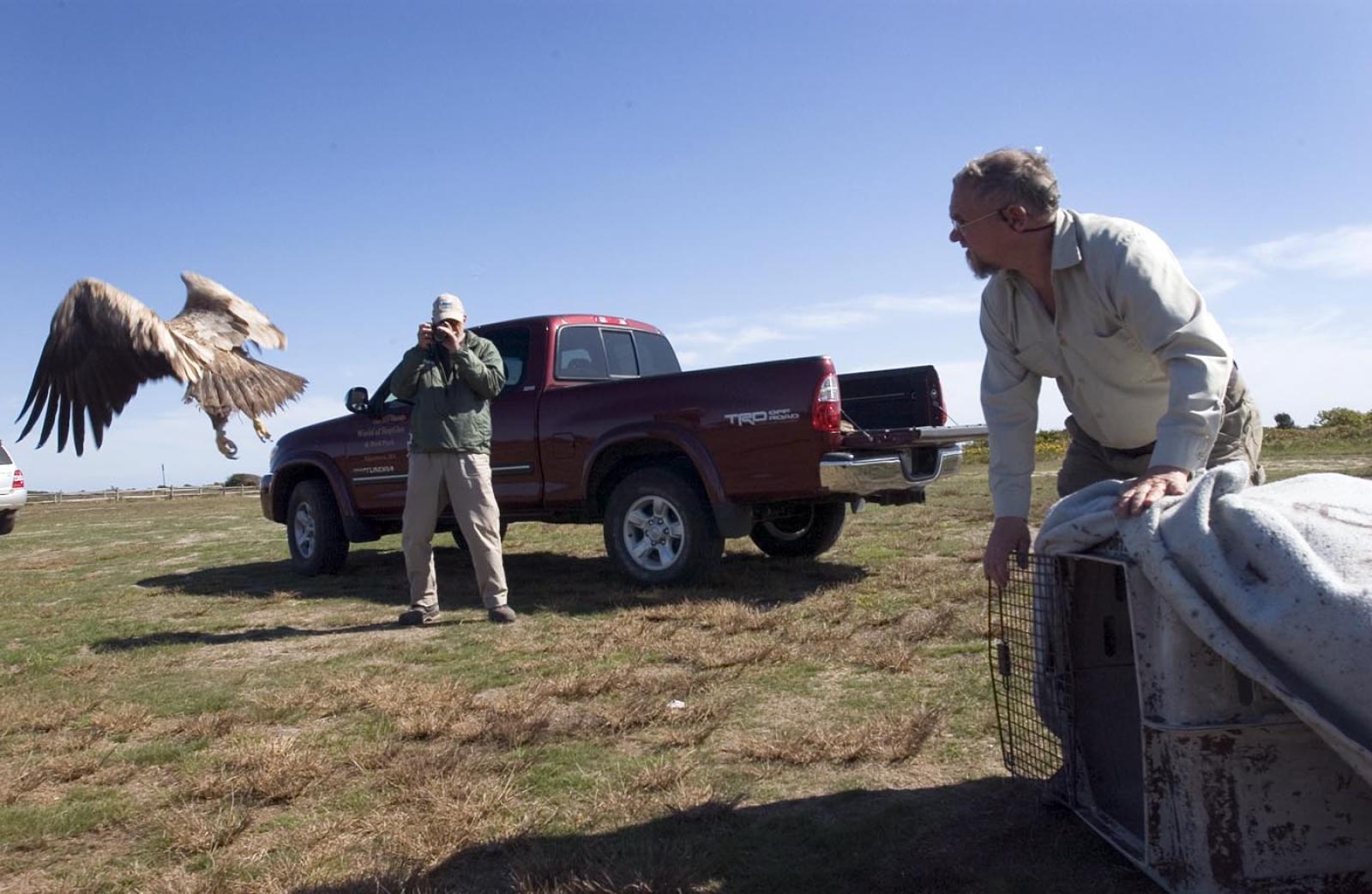A juvenile bald eagle that has been in recovery for over a month was released back into the wild on Tuesday afternoon. Augustus Ben David, the owner of World of Reptiles and Bird Park in Edgartown, had cared for the animal for weeks after it was found disoriented and malnourished on a Chappaquiddick beach.
Mr. Ben David released the bird at South Beach beneath a bright autumn afternoon sun in a stiff east-northeast breeze.
When he opened the cage door, the two-year-old bird immediately took flight and headed toward Edgartown Great Pond.
Mr. Ben David took the eagle on Friday, August 15, after it was discovered by a Chappaquiddick summer resident on a remote section of East Beach, disoriented and nearly unable to fly.
On Tuesday afternoon, the eagle was aggressive and spunky and flew with precision.
“Oh my gosh, she is flying perfectly. Look at those wings,” Mr. Ben David said as he watched the bird with Dick Jennings, a Trustees of Reservations ranger, who had been called first by the people who discovered the bird. The two men stood on the back of Mr. Ben David’s burgundy Toyota Tundra pickup truck, high enough to monitor the bird’s distant motion. Mr. Ben David held his binoculars; Mr. Jennings pointed his camera.
As the bird flew away, other birds rose in the eagle’s flight path.
“We hope we never hear from her again,” Mr. Ben David said.
But he did, briefly.
After seeing the eagle fly off and loading the cage back into his truck, Mr. Ben David said he and Mr. Jennings drove over to a private piece of property near the Great Pond to investigate concerns he had about a long-standing osprey pole near a new home construction site. As Mr. Ben David stood near the osprey pole, his friend the eagle did a flyover.
“Overhead, the eagle flew right overhead. I couldn’t believe it. It came in and did a circle around us and then disappeared,” Mr. Ben David said later. “Can you believe it? It was just 20 feet overhead.”
Mr. Jennings offered his own thoughts. “I think that bird flew over us just to say to Gus it was okay and then was saying a final goodbye,” he said.
The troubled juvenile bald eagle was discovered by Victor Colantonio, who lives near the Cape Pogue Lighthouse. He was out that Friday morning watching thousands of sparrows flying over the area. He and his wife Dawn and some friends saw the juvenile eagle acting in a peculiar manner. He thought the bird was injured.
Mr. Colantonio notified The Trustees. Mr. Jennings, along with Elizabeth (Liz) Baldwin, a Trustees shore bird biologist, went out to Cape Pogue to investigate. When they confirmed Mr. Colantonio’s observations, Mr. Ben David was notified. He arrived Saturday morning and took the bird home.
Bald eagles are protected by state and federal law and it is illegal to possess or capture one. But Mr. Ben David, who is the former longtime director of Felix Neck Wildlife Sanctuary and a preeminent naturalist, has legal authority to capture and care for injured birds. He has handled many eagles and other birds and animals over the years. He keeps two eagles for educational purposes, an 18-year-old female bald eagle named Wrangler and a 28-year-old female golden eagle named Chameli.
Mr. Ben David kept the young eagle in a pen with Wrangler and fed it laboratory mice.
He said the bird responded quickly, though he remains concerned about how the bird got into trouble in the first place. At the time of its release, Mr. Ben David believes he doubled the bird’s weight to seven pounds. He cared for the bird at his own expense, feeding it the equivalent of a full-size rabbit a day.
He also stayed in close contact with Dr. Tom French, assistant director of the Natural Heritage and Endangered Species program of Mass Wildlife. The two men are friends and colleagues.
Two weeks ago Mr. Ben David said he realized that the color of the bird did not match the color of other immature bald eagles he had seen before. He began to think the bird might not be a bald eagle, but a distant cousin, a juvenile white-tailed sea eagle.
The white-tailed sea eagle is commonly found in England and Scotland.
He conferred with an authority on white-tailed sea eagles. He sent letters and pictures of the bird to Roy Dennis, the honorary director of the Highland Foundation for Wildlife in Scotland. Through their correspondence Mr. Ben David was given advice on how to distinguish the traits of a juvenile sea eagle from a bald eagle.
After recapturing the bird in the pen, spreading its tail feathers and checking other traits, Mr. Ben David finally concluded that the bird was in fact an extraordinarily faded juvenile bald eagle. He wonders whether the bird is leucistic (a condition characterized by reduced pigmentation in animals) and whether its light appearance will continue into adulthood. “They take from five to seven years to get full adult plumage,” he said.
Mr. Ben David would appreciate hearing from anyone who sees the bird. He said the eagle is pretty easy to identify, as it also has a shiny aluminum federal band on its right leg. He can be reached at 508-627-5634 .







Comments
Comment policy »